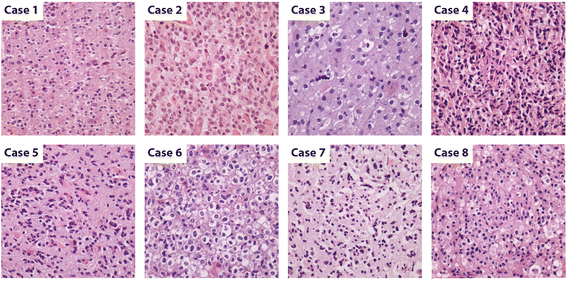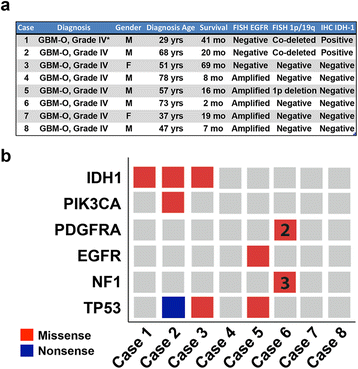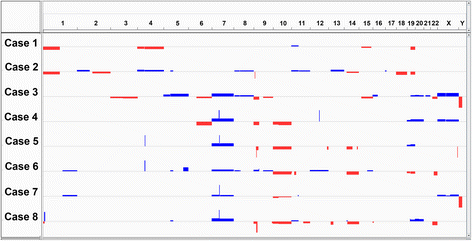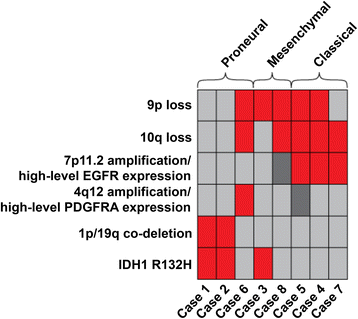Farewell to GBM-O: Genomic and transcriptomic profiling of glioblastoma with oligodendroglioma component reveals distinct molecular subgroups
- PMID: 26757882
- PMCID: PMC4711079
- DOI: 10.1186/s40478-015-0270-7
Farewell to GBM-O: Genomic and transcriptomic profiling of glioblastoma with oligodendroglioma component reveals distinct molecular subgroups
Abstract
Introduction: Glioblastoma with oligodendroglioma component (GBM-O) was recognized as a histologic pattern of glioblastoma (GBM) by the World Health Organization (WHO) in 2007 and is distinguished by the presence of oligodendroglioma-like differentiation. To better understand the genetic underpinnings of this morphologic entity, we performed a genome-wide, integrated copy number, mutational and transcriptomic analysis of eight (seven primary, primary secondary) cases.
Results: Three GBM-O samples had IDH1 (p.R132H) mutations; two of these also demonstrated 1p/19q co-deletion and had a proneural transcriptional profile, a molecular signature characteristic of oligodendroglioma. The additional IDH1 mutant tumor lacked 1p/19q co-deletion, harbored a TP53 mutation, and overall, demonstrated features most consistent with IDH mutant (secondary) GBM. Finally, five tumors were IDH wild-type (IDHwt) and had chromosome seven gains, chromosome 10 losses, and homozygous 9p deletions (CDKN2A), alterations typical of IDHwt (primary) GBM. IDHwt GBM-Os also demonstrated EGFR and PDGFRA amplifications, which correlated with classical and proneural expression subtypes, respectively.
Conclusions: Our findings demonstrate that GBM-O is composed of three discrete molecular subgroups with characteristic mutations, copy number alterations and gene expression patterns. Despite displaying areas that morphologically resemble oligodendroglioma, the current results indicate that morphologically defined GBM-O does not correspond to a particular genetic signature, but rather represents a collection of genetically dissimilar entities. Ancillary testing, especially for IDH and 1p/19q, should be used for determining these molecular subtypes.
Figures





References
-
- Hegi ME, Janzer RC, Lambiv WL, Gorlia T, Kouwenhoven MC, Hartmann C, et al. Presence of an oligodendroglioma-like component in newly diagnosed glioblastoma identifies a pathogenetically heterogeneous subgroup and lacks prognostic value: central pathology review of the EORTC_26981/NCIC_CE.3 trial. Acta Neuropathol. 2012;123:841–852. doi: 10.1007/s00401-011-0938-4. - DOI - PubMed
Publication types
MeSH terms
Substances
Grants and funding
LinkOut - more resources
Full Text Sources
Other Literature Sources
Medical
Research Materials
Miscellaneous

